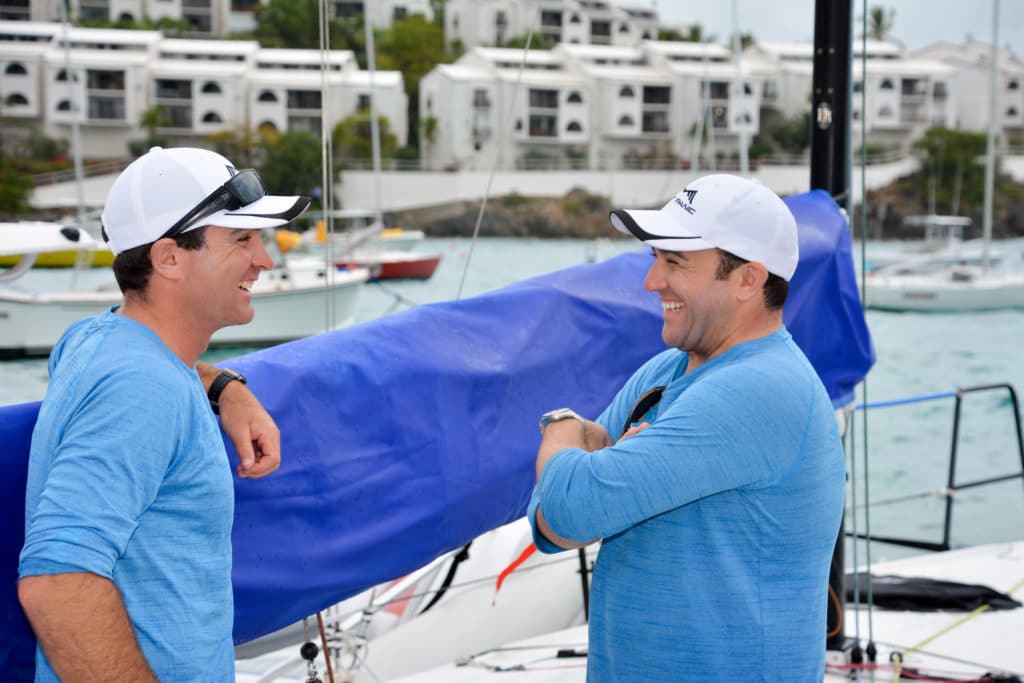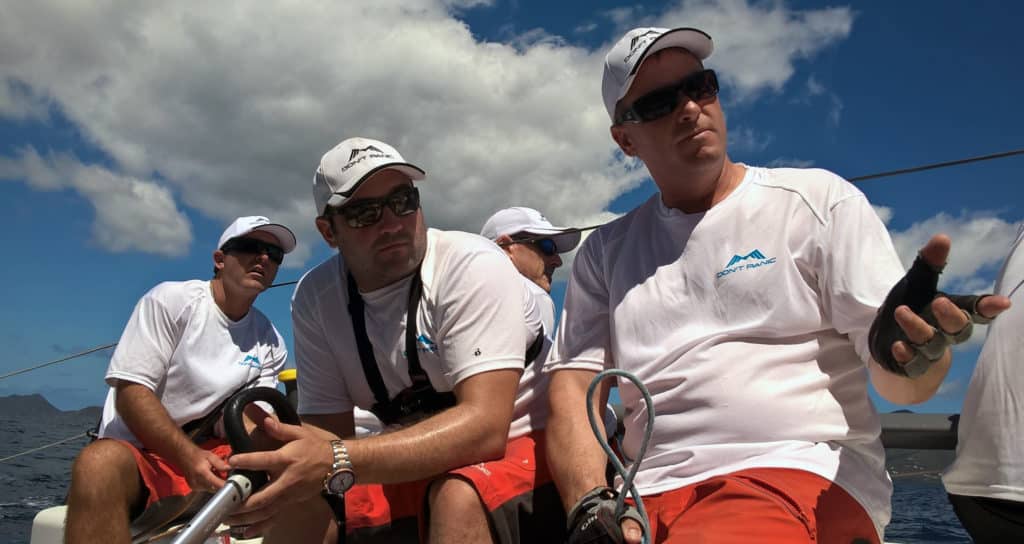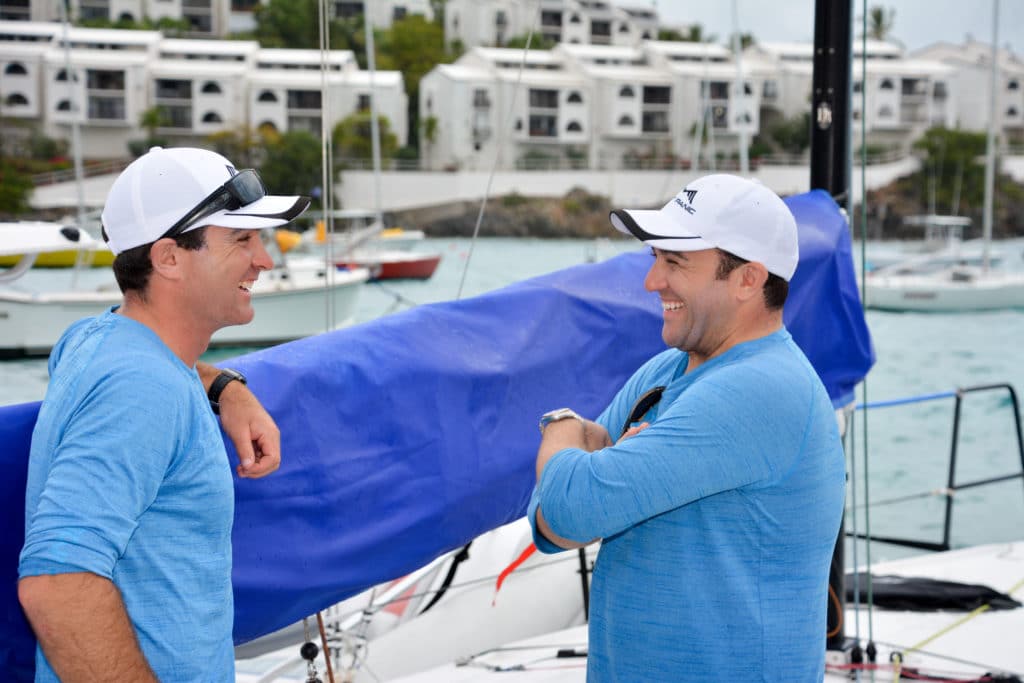
“Let’s get the boat moving here so we have good speed on the exit,”
says Charlie Enright in his characteristically direct tone. The skipper of the 2017-18 Volvo Ocean Race entry Vestas 11th Hour Racing is talking to Julian Mann, owner and helmsman on Don’t Panic, a C&C 30 which he purchased in 2016.
Enright’s working with Mann on light-air transitions. Mann looks up from the helm and quietly explains what he thinks he needs to do to make some improvements. Enright responds, “Julian, if you hear hike or weight, it’s only effective if you’re going straight.”
It’s not intended as a smartass comment, just good, honest feedback from Enright who has been hired by Mann to take his relatively new team to the next level. It’s week two in the Caribbean for the Don’t Panic program and they’re taking a training day prior to BVI Spring Regatta. They’ve just come off the 2017 St Thomas International Regatta (STIR) where they took second in class, good but not enough for Enright who knows one goal: aim to win, whether on a C&C 30 or Volvo Ocean 65.
STIR was only the third major regatta for Don’t Panic and its crew, mainly from the San Francisco Bay Area. Under the guidance of Pete McCormick, who works for North Sails out of its Sausalito location and is project manager for the Don’t Panic program, Mann elected to buy a C&C 30 after chartering the boat for Key West 2016.
“I like throwing myself into the deep end and wanted something that was fast and exciting,” says Mann, an aeronautical engineer and entrepreneur who sold a company he co-founded to Google some four years ago. “Once I surveyed the landscape it seemed like the C&C 30 was a growing class and an exciting boat that would be a challenge but one that was going to be achievable. I wanted a really good development platform as I look to the future of perhaps a TP 52 or a bigger high performance sled.”
McCormick helped Mann put together a crew made up of guys from the St Francis YC, some longtime friends of Mann’s and new friends he’s met as part of building the Don’t Panic program. The first regatta they raced was the 2016 Big Boat Series, where they finished last in class after a performance they are not keen to repeat. Between Big Boat and Key West 2017, the team continued to work on crew development and boatspeed, which included a tuning session in Fort Lauderdale last December when Enright joined them for some coaching. Mann was especially encouraged to see how that time with the Volvo veteran played out at Key West. Don’t Panic took fourth in a tight fleet of five with just three points of separation between them and the boat that finished second.
Meeting Enright was a turning point for Mann and his C&C 30 program. While the pair are similar in age-— Mann had just turned 31 and Enright 33 — their experience racing high performance boats is a world apart. Mann, who is from Northern California, grew up sailing dinghies while on family vacations in the Boston area. While at Stanford, he started racing on a Beneteau First 42 doing beer cans in San Francisco Bay as well offshore racing including Coastal and Spinnaker Cup events before becoming consumed by his high-tech career. Enright, on the other hand, has sailed his entire life at the highest level, accumulating thousands of offshore miles and inshore racing results – including a Transatlantic and Rolex Fastnet Race in 2011 and a full time Volvo Ocean Race campaign as skipper on Team Alvimedica in the 2015-16 event.
Mann immediately connected with Enright and importantly, favored the chemistry among the crew with him on the boat. Fortunately, Enright was available to race with Mann for a few weeks at the upcoming Caribbean regattas: a few weeks later, Enright would have been 100-percent focused on his new Volvo campaign and unavailable. As different as their backgrounds are, Mann and Enright share the commonalities of both having reached the top of their respective games where they played key leadership roles at a relatively young age, and the mutual respect between the pair is obvious.
As the team prepared dockside at the St Thomas YC for the STIR Round St. John race, Enright communicated his objectives: to analyze how the team was working and more specifically understand how it was all coming together to provide Julian with the information he needed to helm the boat optimally. They would treat the race as a training day to settle into positions on the boat and for Enright to get a feel for what he was working with.

By the end he could certainly better describe what he was feeling but also what he needed from different people on the boat as far as trim, ease, weight in, weight out, runner down – he was starting to not only learn the sensations but what helps remedy some of those sensations and how he can keep the boat moving quicker through the water.
The atmosphere on the boat was amiable, if not a little apprehensive given the team hadn’t sailed together in over two months. In addition to Enright, two new guys were on aboard — John Bonds Jnr, from San Francisco, and pro Alec Anderson from Tortola, British Virgin Islands. Anderson, who campaigned the 49er for the 2016 Olympics, worked as offside trimmer, pit, and strategist providing valuable local knowledge. Bonds, with many years of high level national and international racing and coaching under his belt stepped in as navigator while Enright called tactics.
Don’t Panic got off to a great start for the 15-nautical mile distance race in typical Caribbean conditions – 10 to 12 knots from the east. They showed good wheels downwind, which put them in a powerful position for the first half of the race but ultimately rounded into the team’s weakness, upwind light air. They ended the day in fourth — of a fleet of four — a result which Enright took in stride.
“It’s OK because we wouldn’t be learning if was windy all week, right?” he said, debriefing with Julian on the boat at the end of the race. “To improve we’d like to have more of the light air conditions that we struggle in – the goal is always to continue the upward trajectory. I think we focused on the process and we’re continuing to improve.” Mann concurred, “We want to be as competitive as we can be so we need to get the light air mode further dialed in. Today continued to feel like when we’re in our mode, when we have the pace, we are very competitive.”
The voice of experience interjected, “I think there are conditions that suit our strengths and we’re racing complete but when the conditions don’t suit our strengths, we’re still racing ourselves,” Enright stated firmly. About that time a tray of painkillers arrived, Julian cracked a joke and the pair called it a day.
 |
Subscribe Now and Save 58% |
Fast forward a week, after three days of STIR racing in big air and waves with mixed results, the team made its way over to the BVI Spring Regatta. Call it the Caribbean effect, or perhaps it was because girlfriends and wives had flown in, but the vibe on Don’t Panic was 180 degrees from that of a week earlier — the boys had loosened up and there was an agreeable feeling of quiet confidence among the team. After a training day where they lined up with Themis for some serious repetitive light air work, the team went into three days of BVI Spring Regatta racing. They sailed seven races, taking three bullets in the first three races and winning the Regatta with 14 points. Not bad for a new team sailing its fourth regatta ever.
“From the beginning they were everything you would expect from a new team from San Francisco,” Enright said. “In the breeze they are fast but the boat handling needs to improve, and in the light air, the boat handling is ok but the speed needs to improve. Julian really came up the learning curve, quickly improving his light helming and how to transition the boat in difficult conditions. By the end he could certainly better describe what he was feeling but also what he needed from different people on the boat as far as trim, ease, weight in, weight out, runner down – he was starting to not only learn the sensations but what helps remedy some of those sensations and how he can keep the boat moving quicker through the water.”

For Mann, there are a few easy lessons learned. “For sure, we have to stay focused on racing the fleet and not ourselves,” he says. “For me, I’m figuring out what I need to do in order to reassess situations to get the boat moving again when we lose focus even for just a moment. Clearly, when races are being won by seconds, small is big.”
Enright offers that the Don't Panic program is trending in the right direction and hopes that Mann will use the team's recent good results as a way to attract new people to the boat as the crew continues to evolve. "We need to use this result to fill those seats with the best people we can," he said, adding that he thinks the team should continue to use a coach moving forward.
“I played that role for them a bit on the boat but as it’s a fairly young and inexperienced group, it would be good for them to have some gray hair in the line up somewhere and a coach might be a good place for that.”
That should not be a problem for Mann. Both he and Enright are masters at surrounding themselves with better people. “You can learn from them,” Enright laughed. “Seriously, if you can put yourself in a position where you are the weakest link on the boat, all of a sudden that boat has a pretty good chance of doing well.” And, it’s a philosophy Enright subscribes to with his Volvo campaigns.
“The programs are drastically different but a team is a team and just the way that you build a team, whether it’s to sail around the world or the Caribbean, there are a lot of parallels and as Julian likes to point out, rightfully so, there are also a lot of parallels to how he builds his company. Successful people tend to be successful at whatever they do.”
Editor's note: Organizers of the St. Thomas International Regatta (STIR) confirms the event is set for March 23 to 25, and will take place as scheduled despite damage to the island from Hurricane's Irma and Maria. For more information on charter boats and racing opportunities in the "throwback version," visit the regatta site at STIR.










